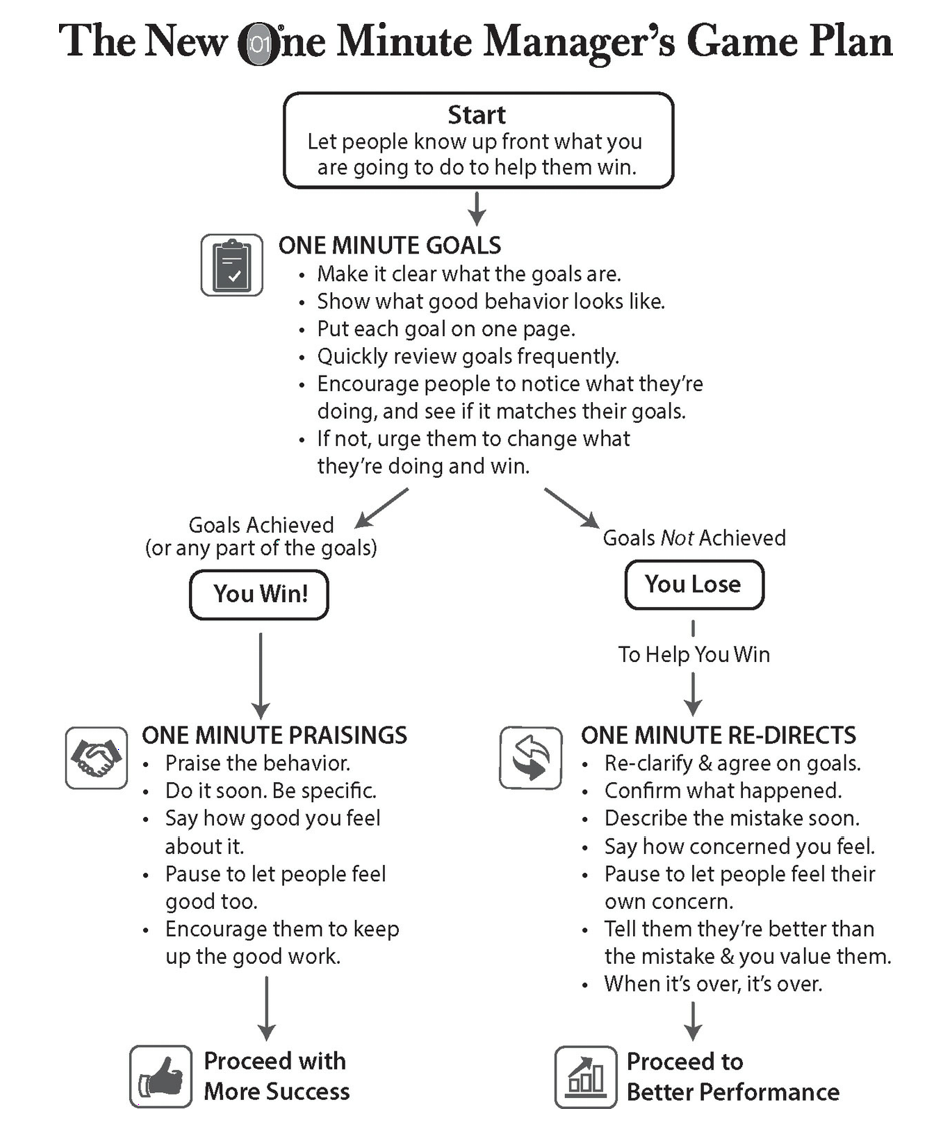The New One Minute Manager

This book attempts to distill down the job of a manager into a set of three one-minute components:
- One Minute Goals
- One Minute Praisings
- One Minute Re-directs
This is a pretty short book (111 pages), and I would recommend you read it if you manage anyone. However, you can learn a lot of what this book has to offer by going over the Game Plan at the end of the book:

Here are my highlights from this book:
- To succeed sooner, managers must be both results-oriented and people-oriented.
People Who Feel Good About Themselves Produce Good Results.
- 80% of your really important results will come from 20% of your goals. So we set One Minute Goals on only that 20%—that is, our key areas of responsibility—maybe three to five goals. Of course, in the event a special project comes up, we set special One Minute Goals.
ONE MINUTE GOALS WORK WELL WHEN YOU:
- Plan the goals together and describe them briefly and clearly — show people what good performance looks like.
- Have people write out each of their goals, with due dates, on a single page.
- Ask them to review their most important goals each day, which takes only a few minutes to do.
- Encourage people to take a minute to look at what they’re doing, and see if their behavior matches their goals.
- If it doesn’t, encourage them to re-think what they’re doing so they can realize their goals sooner.
A ONE MINUTE PRAISING WORKS WELL WHEN YOU: THE FIRST HALF-MINUTE
- Praise people as soon as possible.
- Let people know what they did right—be specific.
- Tell people how good you feel about what they did right, and how it helps. PAUSE
- Pause for a moment to allow people time to feel good about what they’ve done. THE SECOND HALF-MINUTE
- Encourage them to do more of the same.
- Make it clear you have confidence in them and support their success.
IF THE GOAL IS CLEAR, A ONE MINUTE RE-DIRECT WORKS WELL WHEN YOU: THE FIRST HALF-MINUTE
- Re-Direct people as soon as possible.
- Confirm the facts first, and review the mistake together—be specific.
- Express how you feel about the mistake and its impact on results. PAUSE
- Be quiet for a moment to allow people time to feel concerned about what they’ve done. THE SECOND HALF-MINUTE
- Remember to let them know that they’re better than their mistake, and that you think well of them as a person.
- Remind them that you have confidence and trust in them, and support their success.
- Realize that when the Re-Direct is over, it’s over.
- Praising people doesn’t always work if it isn’t combined with Re-Directs to correct mistakes when they occur.
- As soon as he becomes aware of the mistake. He confirms the facts with me and we review what’s gone wrong. He’s very specific. “Then he tells me how he feels about the mistake and its possible impact on our results, sometimes in no uncertain terms. “After he tells me how he feels, he’s quiet for a few seconds to let it sink in. That quiet pause turns out to be surprisingly important.
- In the second part of the Re-Direct, he reminds me that I’m better than my mistake and that he has confidence and trust in me. He says he doesn’t expect a repeat of that mistake and looks forward to working with me.
Goals make clear what is most important to focus on, Praisings build confidence that helps you succeed, and Re-Directs address mistakes. All three of these help people feel better about themselves and produce good results.
- When you assume that people know what’s expected of them, you are creating an ineffective form of bowling. You put the pins up, but when the bowler goes to roll the ball, he notices there is a sheet across the pins. So when he rolls the ball and it slips under the sheet, he hears a crack but doesn’t know how many pins he knocked down. When you ask him how he did, he says ‘I don’t know. But it felt good.’
- How do you think you would be viewed by your boss if you rated everyone that reported to you at the highest level on your performance review scale?” “Probably as a soft touch—someone who can’t discriminate between good performance and poor performance.
- This has been a popular management style for a long time. I call it the leave-alone-zap style. You leave a person alone, expecting good performance from them, and when you don’t get it, you zap them.
- A One Minute Re-Direct is intended to help people learn. However, when a person has learned something and has shown they can do it, but they have a won’t do attitude, you need to look at the cost to the organization, and whether you can afford to keep such a person on the team.
Goals Begin Behaviors. Consequences Influence Future Behaviors.
This is #55 in a series of book reviews published weekly on this site.